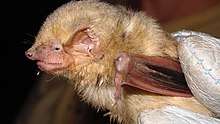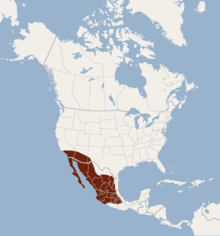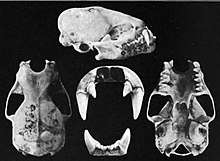Western yellow bat
The western yellow bat (Dasypterus xanthinus) is a species of vesper bat. It is found in Mexico and the southwestern United States. This species roosts in trees such as Populus fremontii, Platanus wrightii, and Quercus arizonica.[2] If available, the western yellow bat will use the dead fronds that encircle palm trees as a roosting site.[3]
| Western yellow bat | |
|---|---|
 | |
| Scientific classification | |
| Kingdom: | Animalia |
| Phylum: | Chordata |
| Class: | Mammalia |
| Order: | Chiroptera |
| Family: | Vespertilionidae |
| Genus: | Dasypterus |
| Species: | D. xanthinus |
| Binomial name | |
| Dasypterus xanthinus Thomas, 1897 | |
 | |
| Geographic range of the western yellow bat | |
| Synonyms | |
| |
Taxonomy and etymology
It was described as a new subspecies of bat in 1897 by British zoologist Oldfield Thomas. He listed it as a subspecies of the southern yellow bat, with a trinomen of Dasypterus ega xanthinus.[4] In 2015, Baird et al. argued that this species and other yellow bats should be in the genus Dasypterus,[5] though others have since argued that Dasypterus should remain a subgenus of Lasiurus.[6] In 1988, Baker et al. argued that it should be considered a full species based on its genetics.[7] Its species name "xanthinus" is from Ancient Greek xanthos, meaning "pertaining to yellow."[8]
Description

The western yellow bat is a small species, though it is larger than the southern yellow bat. Its fur is bright yellow. Individuals weigh approximately 16 g (0.56 oz). Its forearm length is 42–47 mm (1.7–1.9 in). Its dental formula is 1.1.2.33.1.2.3 for a total of 32 teeth.[9]
Range and habitat
Its range includes the Southwestern United States of Arizona, California, and New Mexico, in addition to parts of Mexico. It is found in West and Central Mexico, as well as Baja California.[1]
Conservation
As of 2017, it is evaluated as a least-concern species by the IUCN. It meets the criteria for this category because it has a wide geographic range; its population is presumably large; its range includes protected areas; and it is unlikely to be experiencing rapid population decline.[1]
References
- Arroyo-Cabrales, J.; Álvarez-Castañeda, S.T. (2017). "Lasiurus xanthinus". The IUCN Red List of Threatened Species. 2017: e.T41532A22004260. doi:10.2305/IUCN.UK.2017-2.RLTS.T41532A22004260.en.
- "Lasiurus xanthinus - Western Yellow Bat". InfoNatura. NatureServe. Retrieved 2009-07-04.
- Hoffmeister, Donald F. (1986). Mammals of Arizona. Arizona Game and Fish Department. pp. 100–101. ISBN 978-0-8165-0873-0.
- Thomas, O. (1901). "LXVI.—Descriptions of new bats and rodents from America". The Annals and Magazine of Natural History; Zoology, Botany, and Geology. 6. 20 (120): 544. doi:10.1080/00222939709487398.
- Baird, Amy B; Braun, Janet K; Mares, Michael A; Morales, Juan Carlos; Patton, John C; Tran, Christina Q; Bickham, John W (2015). "Molecular systematic revision of tree bats (Lasiurini): Doubling the native mammals of the Hawaiian Islands". Journal of Mammalogy. 96 (6): 1255–1274. doi:10.1093/jmammal/gyv135.
- Novaes, Roberto Leonan M; Garbino, Guilherme S. T; Cláudio, Vinícius C; Moratelli, Ricardo (2018). "Separation of monophyletic groups into distinct genera should consider phenotypic discontinuities: The case of Lasiurini (Chiroptera: Vespertilionidae)". Zootaxa. 4379 (3): 439–440. doi:10.11646/zootaxa.4379.3.8. PMID 29689956.
- Baker, R. J.; Patton, J. C.; Genoways, H. H.; Bickham, J. W. (1988). "Genic studies of Lasiurus (Chiroptera: Vespertilionidae)". Occasional Papers, the Museum, Texas Tech University (117).
- Stangl, F. B.; Christiansen, P. G.; Galbraith, E. J. (1993). "Abbreviated guide to pronunciation and etymology of scientific names for North American land mammals north of Mexico" (PDF). Occasional Papers, the Museum, Texas Tech University (154): 1–28.
- Aguilar, S.; Leon P., Livia; Morales, J.C. (2014). Ceballos, G. (ed.). Mammals of Mexico. JHU Press. pp. 822–824. ISBN 978-1421408439.
